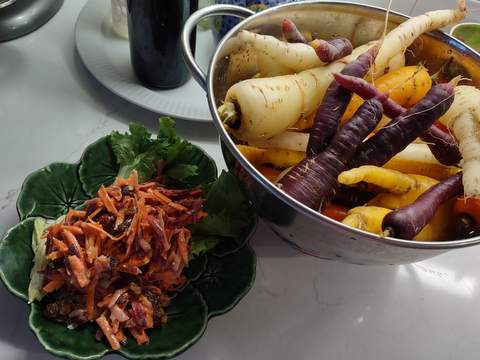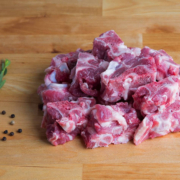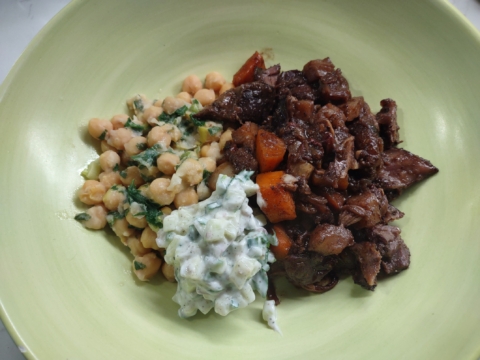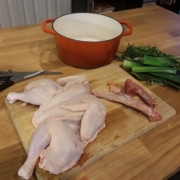Brown Butter Would Taste Good on Garden Sheers
There’s a lot going around on the foodie interwebs right now about brown butter and toasted heavy cream, for plenty of dang good reasons. Like my pasty, somewhat chunky sun-tanning sister-in-law says, “Brown fat is better than white fat.”
So I thought I’d create a brown butter almond cookie. Before you go zooming off to see if I’m stealing this idea from someone, I’ll tell you a little story.
One day my good friend Chef Krystyna Livingston and I were planning a Syrian dinner for Chefs Collective, our little gig at Ruby June Inn.
We were going to make pickles from some watermelon rind, a much loved thing in Syria, and I said, “Hey, we’ve got all this watermelon fruit. Instead of using pomegranate molasses, why don’t we make watermelon molasses?” We both felt like total creative geniuses. Until the next day, when just out of curiosity, and because my friend and fellow chef John Helleberg had just told me that everything you can think of is already on the web, I googled “watermelon molasses.” Not one, but three recipes popped up. So, genius: another moniker I can’t claim.
Anyway, you are correct. Probably are some cookies out there with brown butter, but I ain’t even gonna look. Besides, mine have a cute little trick. Instead of roasting my almonds (or walnuts – both are good) in a saute or in the oven before I bake the cookies, I grind them fine, and roast them in the melted brown butter. Then I put the melted butter and nuts in the fridge, and let them cool to almost firm, and make the cookies. Now I feel like a genius.
Brown Butter Almond Cookies
4 ounces (1 cube) salted butter
68 grams finely ground whole raw unsalted almonds
¼ cup maple sugar (not syrup … sugar)
¼ light brown sugar
½ cup white sugar
1 egg
1 teaspoon vanilla (or half a teaspoon vanilla and half a teaspoon almond extract)
47 grams, blended whole grain oats (blend them fine like flour)
1 cup flour
½ teaspoon baking soda
½ teaspoon baking powder
½ teaspoon kosher salt
Start the butter in a small saute pan or saucepan on medium heat. When the butter is melted, and is bubbling and golden brown, with lots of browning bits on the bottom, stir in the almonds, and stir and continue browning on medium heat for about 3 minutes. Pour into a bowl, scraping in all the brown bits, and place in the fridge for 30 minutes until soft-firm, about the consistency you would like butter to be when you are planning to blend sugar and butter together for cookies, which you are!
Place the semi-cold butter and almonds in the bowl of a kitchen aid, add the sugars, and cut them together until light and fluffy. Add the egg and vanilla and beat until combined. Dump in the flour, soda, baking powder, salt and oat flour. If you are extremely anal, you can mix your dry ingredients together first, but frankly, I can tell no difference one way or the other. Heretic? Sure thang.
As soon as the cookie dough comes together, stop mixing. Place the dough in the fridge and let it cool about 30 minutes.
Using a small scoop, scoop out a ball, place it on a cookie sheet, and flatten it with the bottom of a greased glass. You want them pretty thin.
Bake at 350 for 12 minutes until golden brown.








 Two passions: food, words. Some days, it’s a tug of war, some days, a peaceful coexistence.
Best day ever? Create it, cook it, eat it, write about it. I sold my restaurant, Nora’s Table, in 2015, and now I can be possessed by anything in the long day that I choose: writing 400 words, creating the next menu for the Chefs Collective at Ruby June Inn, teaching a cooking class at Jacob Williams Winery, or tromping through the fields with farmer Laurel Bouret.
A rainy afternoon with a foundational cookbook, such as Marlene Mater’s fabulous “Allepo Cookbook” or Michael Ruhlman and Brian Polcyn’s “Charcuterie” can feed my spirit and spark my creative power. So can reading Maggie Shipstead, Michael Chabon or Alison Kraus.
I live in Hood River, Oregon, with Stuart, also known as the Happy Meal Man. In other words, all I can desire. And then there’s Satchel, our six-year old Idaho Shag who is simply the world’s best dog. We run together, and sometimes, we even let Stu join us.
Our oldest daughter Annie and grandson Levi live in Eugene, Oregon. Annie is cooking in restaurants, like her Mom. Son Max and his wife Hannah and our granddaughter Shiloh are in Portland, where he is a school principal. It’s a good tribe, all the way around.
Two passions: food, words. Some days, it’s a tug of war, some days, a peaceful coexistence.
Best day ever? Create it, cook it, eat it, write about it. I sold my restaurant, Nora’s Table, in 2015, and now I can be possessed by anything in the long day that I choose: writing 400 words, creating the next menu for the Chefs Collective at Ruby June Inn, teaching a cooking class at Jacob Williams Winery, or tromping through the fields with farmer Laurel Bouret.
A rainy afternoon with a foundational cookbook, such as Marlene Mater’s fabulous “Allepo Cookbook” or Michael Ruhlman and Brian Polcyn’s “Charcuterie” can feed my spirit and spark my creative power. So can reading Maggie Shipstead, Michael Chabon or Alison Kraus.
I live in Hood River, Oregon, with Stuart, also known as the Happy Meal Man. In other words, all I can desire. And then there’s Satchel, our six-year old Idaho Shag who is simply the world’s best dog. We run together, and sometimes, we even let Stu join us.
Our oldest daughter Annie and grandson Levi live in Eugene, Oregon. Annie is cooking in restaurants, like her Mom. Son Max and his wife Hannah and our granddaughter Shiloh are in Portland, where he is a school principal. It’s a good tribe, all the way around.